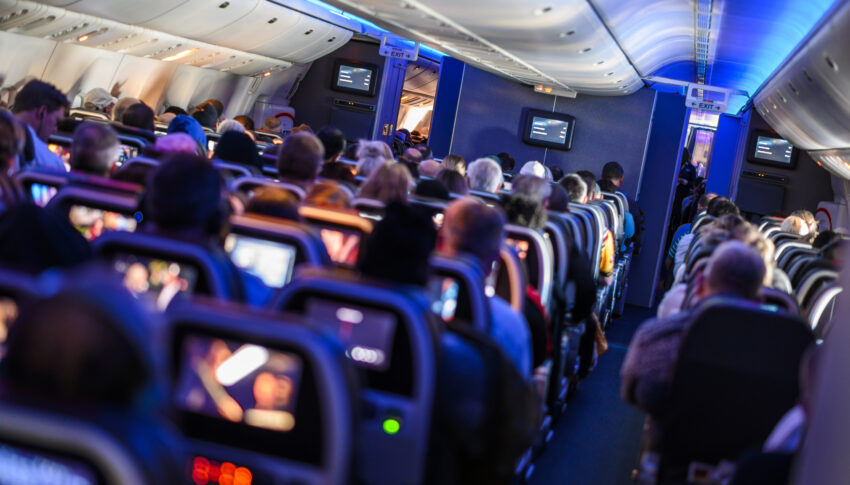With the 4K revolution at home, to what extent is the new ultra high-definition content and screen world arriving in the aircraft? What are the technological blockers to 4K video across the world’s airline fleet, and why do so many films and TV shows still look low-definition? We sat down with experts from Panasonic Avionics and Safran Passenger Innovations to learn more.
It’s a rare big screen TV, new blockbuster movie or latest must-watch TV show that isn’t in ultra-high definition (UHD) 4K resolution these days. But just like every movie or show in a streaming service’s library — particularly older content — isn’t 4K, the same is true with airline inflight entertainment, or IFE.
Safran Passenger Innovations’ vice president for product and strategy Ben Asmar tells us that “when it comes to the aircraft, most recent modern IFE systems are now offering 4K screens, but just like at home most of the content available is not 4K. In fact, sadly the majority is still 480p.”
In TV terms, 480p was superseded by high-definition TV, which usually means 720p and up, in the late 1990s and early 2000s. So why are aircraft still showing 480p? By and large, it’s because of the studios that produce content charge more for higher definition versions of movies and shows.
“There’s a disconnect between the 4K UHD content world and the 4K UHD screen seatback display world,” Gary Kaplan, product marketing manager at Panasonic Avionics, tells us. “The introduction of 4K UHD screens came well before any wide availability of native 4K content. There are two main reasons for this: the premium cost from content providers for 4K media, and the upscaling capabilities of the IFE system to take lower resolution media and convert it to 4K resolution for display on the 4K screen. With 4K upscaling airlines can be more strategic and selective about their 4K media purchases while still providing passengers with a 4K visual experience for everything they watch.”
This upscaling is not always successful, however, especially in premium classes where the size of the monitor is now pushing towards 20 inches, leading to blur, pixellation and a low-definition experience of these studios’ content.
In terms of the onboard technology, high-definition screens are certainly growing in popularity — and in rollout. Safran cites a market split of 45% 720p, 50% 1080p and 5% 4K for its installation base, with an expected boost to 4K rollout as pandemic-delayed resume.
Other inflight entertainment system manufacturers’ installation bases are similar, with a shrinking amount of legacy 480p-only systems, whose demise has been accelerated by older aircraft being retired during the pandemic.
When it comes to refits of middle-aged cabins, however, there are some further blockers to 4K around legacy aircraft video backbones from servers to seats, which would not normally be upgraded during a cabin refresh, and which often can’t handle 4K to the whole cabin.
“Roughly speaking, you need around 25Mbps for every 4K stream,” Asmar explains. “When you add this up over 300 or more seats you are looking at over 7Gbps of network capacity needed to deliver 4K. Here at SPI, we have already solved this problem: the RAVE system does not stream content to each seat, instead the content is stored locally on storage in each seat display.”
Each seat contains its own solid-state drive, so instead of seat 29B’s system calling one central server to show the content every time its passenger wants to watch a movie, the most popular content like the ‘new onboard’ Hollywood movies will be stored on the device’s own local drive, updated via the usual monthly content loading process to the plane.
But increasingly, part of the storage on these seatback drives are being meshed together to create cloud drives offering terabytes and terabytes of content, enabling very large higher definition libraries to be distributed throughout the aircraft almost like a cloud or RAID storage array.
This kind of system changes the way that the content data is distributed around the aircraft. Part of every system’s drive will be given over to individual pieces of more esoteric content, so a classic movie like Jurassic Park 2: Velociraptor Boogaloo might be stored on the systems of only a subset of seats. If seat 29B wants to watch that movie but doesn’t have it stored locally, the seat 29B system downloads it from one of the other systems, buffering to show the movie as it downloads.
As onboard libraries grow in size to fill these systems, though, the problem of 4K content being so much more expensive will remain. This isn’t a tech problem, it’s a commercial problem. And it’s one that’s even harder to fix.
Author: John Walton
Published: 12th July 2022




